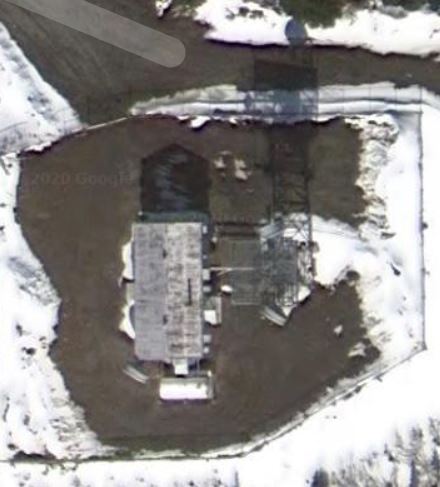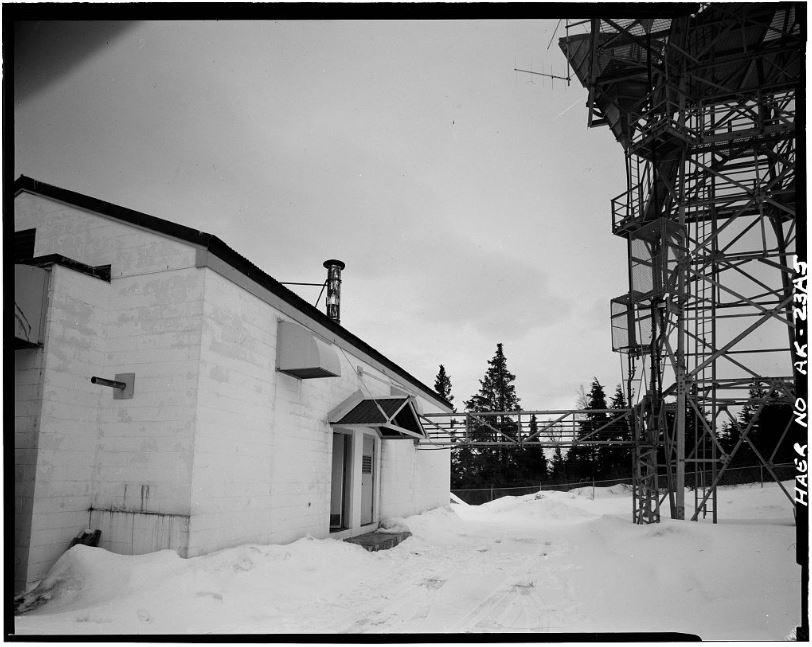
Google Maps - White Alice Rabbit Creek
city-data.com - FCC Registered Microwave Towers in Anchorage, Alaska
Wikipedia - White Alice Communications System

Rabbit Creek White Alice Site Library of Congress 5. VIEW SHOWING ENTRY OF WAVEGUIDES INTO RADIO RELAY BUILDING - Rabbit Creek White Alice Site, Radio Relay Station, Anchorage, Anchorage, AK PHOTOS FROM SURVEY HAER AK-23-A
archives.consortiumlibrary.orgGuide to the United States. Air Force. White Alice Communications System.
Cathedral and Rabbit Creek site plans, 1956-1961
earthquake.alaska.edu - Rabbit Creek 01
TD-2 Microwave Facilities
The TD-2 microwave facilities were much smaller and are simpler to describe. Most generally consisted of one power and equipment building and one microwave tower topped by 'cornucopia' shaped antennas. The towers beamed telephone and telegraph signals by line of sight. Each tower was constructed only as high as necessary to see the station antennas adjacent to it in the network. To ensure the two antennas were of compatible height, they were suspended from helicopters until the signal beamed form one to the other. Only then were the cornucopia antennas placed on the towers. The following extract describes the improvements at the Rabbit Creek Radio Relay Station:
"The station consists of a one-story, steel frame, concrete block building that measures 24' x 51', m/1 {measured length}, for a total area of 1,246 sf. It was built in 1957. Other facilities include one diesel storage tank with a pipeline to the diesel powered standby generator, a sanitary latrine, chain line fence and vehicle parking.
"The Radio Relay Building is steel frame, concrete block, with concrete foundation and concrete slab floor. Steel truss girders support the corrugated steel roofing over 2" x 6" T & G fir. The walls are 14' to the eaves. The building has solid core wood exterior and interior doors with hood quality hardware. It is heated with a McPherson Oil-fired furnace, 110,000 BTU, that provided forced air heat to the building. The building has no plumbing and no windows.
"The radio equipment room has painted concrete floor, painted concrete walls and is open to the under side of the steel truss girders and roof.
"The standby emergency power room has a painted concrete floor, paint concrete block walls, and is open to the roof. This room houses a 2-cylinder General Motors diesel engine, with 20 KW Delco generator.
"The site has one diesel storage tank with 100 barrel capacity, a 213 sq. yd. vehicle parking lot, and is fenced with 543 lineal feet of 8' chain link fence with 3 barb wires.
"Sanitary facilities are provided by a 16 sf plywood outhouse.
This station was built in 1957, is in good condition inside and out, has been well maintained and shows little deferred maintenance" (Follett and Associates 1978: 230).
The Rabbit Creek facility is an active repeater station as shown in photo 1 of the Historic American Engineering Record photographs following this description. After the photographs is a set representative as-built drawings of radio relay stations. The ones included in this report are from the Sawmill and Cathedral facilities because the Rabbit Creek as-built drawings are followed by a site plan and floor plan of the Rabbit Creek installation.
An active repeater of the Rabbit Creek, Cathedral, and Sawmill type amplifies a microwave signal and sends it on to the next station, A passive repeater, on the other hand, has no active parts and is merely a billboard which functions as an optically aligned reflector, much as a mirror reflects a beam of light. It deflects its signal off of a series of such billboards to its final destination. In southcentral Alaska, a passive repeater system functions between Anchorage and Seward. A passive billboard is prominent as one drives south along the Seward Highway, leaving Anchorage. One can be seen across Turnagain arm on Penguin Peak. The Rabbit Creek station, is more complex than this system.
Microwave signals are received at the Rabbit Creek facility from the Anchorage toll center near Elmendorf Air Force Base and from Naptowne, another repeater station, on the Kenai Peninsula. When Rabbit Creek was first opened, signals were received from R1~N. All of these installations were part of the WACS and the Anchorage toll center was the Anchorage ACS. The microwave signal enters on of two cornucopia antennas which sit on top of the 53 foot TD-2 microwave tower. One cornucopia faces Naptowne and the other faces the anchorage toll center. The signals travel down waveguides, entering the radio relay building. Straight sections of waveguides are constructed of copper while curved sections are coated with dense rubber, with copper inside. Note in these photos that there are four waveguides which converge about 10 feet above the ground as they leave the tower and enter the building. This is because two go to each cornucopia and one receives the signal, while the other transmits it.
NAPTOWNE (KENAI Rl-N)
Naptowne is a radio relay station with a 250' TS-2 microwave tower with paths 48 miles north to Rabbit Creek and 17 miles south to Soldotna. It was constructed in 1955-56 and opened 18 January 1957. It was acquired by Alascom in 1983 and is still functioning. It consists of a 1200 sf equipment and power building, a 16 sf sanitary latrine, two POL tanks totalling a 200 barrel capacity and a 595' long chain link fence.
PILLAR MOUNTAIN (KODIAK)
Pillar Mountain was a tropo station linking Diamond Ridge 135 miles north by 60' antennas. An original intention of Western Electric was to have Pillar Mt. also link Sitkinak, 107 miles away. However, when project Stretchout was completed, Sitkinak was unnecessary, so this link was never made. Pillar Mt. also served other government and private entities—U.S. Navy, F.A.A., and R.C.A., for example. The Navy was linked via Cape Chiniak, another station intended as a WACS but, like Sitkinak, never opened as such. Pillar Mountain was constructed in 1957 and opened on 26 April of that year. All components were not completed until 1965. The composite building was 4960 sf, and there were also an auto maintenance building, water and fire pump building, water storage tank and POL storage. The facility is now abandoned and is pending conveyance and possible use by the City of Kodiak.
RABBIT CREEK (POTTER, Rl-S)
Rabbit Creek was an unattended TD-2 microwave radio relay station between Naptowne, 48 miles south, and Rl-N, on Elmendorf AFB, 12 miles north. It was built in 1955-56 and opened on 18 January 1957. It was acquired by Alascom in 1983 and still functions as it did originally. The site consists of a 1200 sf equipment building, a latrine, and a 100 barrel POL tank. Because it contains most of its original equipment and is so well maintained, it was chosen for archival recordation to National Park Service standards during the course of this project. The photographs, copies of which are in this report, will be sent to the Library of Congress in Washington, D.C. and representative as-built drawings will be deposited at the University of Alaska, Anchorage archives. The reason why Rabbit Creek as-builts do not appear in this report is because there are only three in existence, and these are not original. Because the TD-2 stations are all virtually identical, Sawmill and Cathedral as-builts are used instead for report purposes.
Rl-N (ANCHORAGE Rl-N)
This is an unattended TD-2 microwave relay station which connects Neklasson Lake, 32 miles east, Rabbit Creek, 12 miles south, and Anchorage ACS (Alascom Toll Center), 3 miles south. It was constructed in 1956 and opened on 29 November of that year. While it is located on Elmendorf AFB, Alascom owns the microwave equipment. It consists of a small equipment and power building and the TD-2 tower.